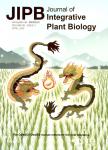Ultrastructural Studies on the Development of Oil Cells in Litsea pungens
木姜子油细胞发育的超微结构研究(英文)作者机构:莱阳农学院基础部植物研究室 西北大学植物研究所西安710069
出 版 物:《Acta Botanica Sinica》 (Acta Botanica Sinica(植物学报:英文版))
年 卷 期:2001年第43卷第4期
页 面:339-347页
核心收录:
学科分类:0710[理学-生物学] 07[理学] 071009[理学-细胞生物学]
基 金:SupportedbytheShaanxiNaturalScienceFoundation (98SM0 5 )
主 题:Litsea pungens oil cells development ultrastructure suberin layer cupule
摘 要:The developmental process of oil cells in the shoot of Litsea pungens Hemsl. has been studied with transmission electron microscopy. According to the development of the three layers of cell wall, the developmental process could be divided into 4 stages. In stage 1, the cell wall consisted only of a primary (the outmost) cellulose layer, which might further be divided into two substages, the oil cell initial, and the vacuolizing oil cell. During this stage, there were some small electron translucent vesicles and dark osmiophilic droplets of variant sizes in the different-shaped plastids. It was observed that some dark and gray osmiophilic materials coalesced to vacuoles in the cytoplasm. In stage 2, a lamellated suberin layer accumulated inside the primary cellulose layer. In stage 3, a thicker and looser inner cellulose wall layer was formed gradually inside the suberin layer. Some dark osmiophilic droplets have been observed in this loose inner cellulose wall layer. The plasmodesmata were blocked up and became a special structure. Then, the big vacuole, which is the oil sac, was full of osmiophilic oil. In stage 4, the oil cell became matured and the cytoplasm disintegrated. The oil sac enveloped from plasmalemma was attached to the cupule, which was formed by the protuberance of the inner cellulose wall layer into the lumen. After the maturity of oil cell, the ground cytoplasm began to disintegrate and became electron opaque or exhibited in a disordered state, and the osmiophilic oil appeared light gray.



